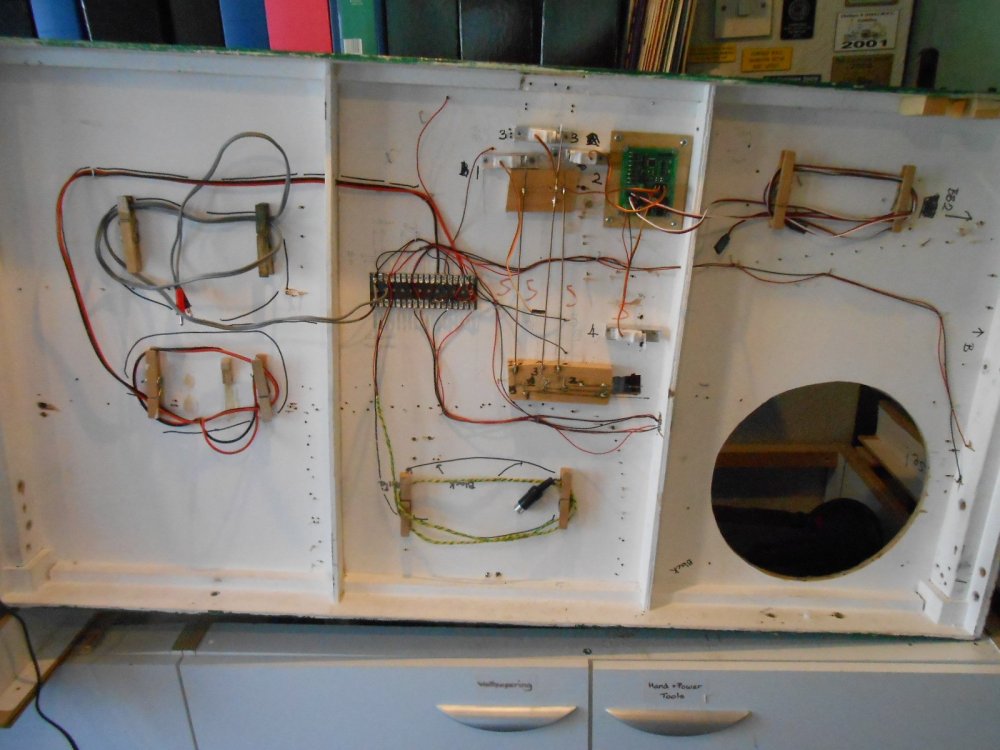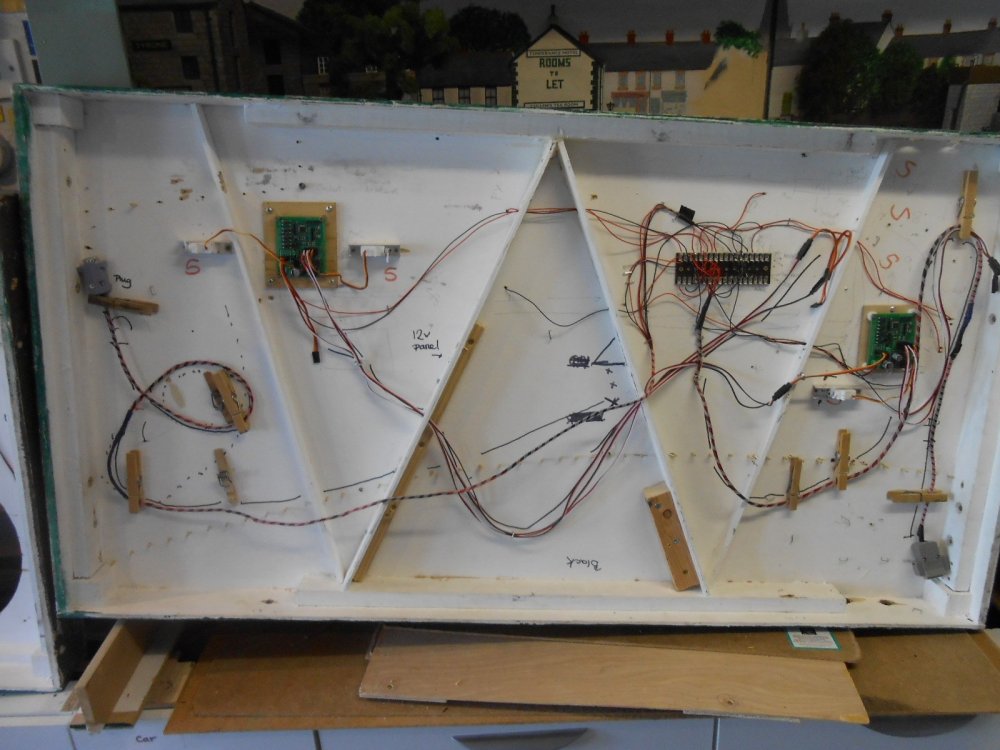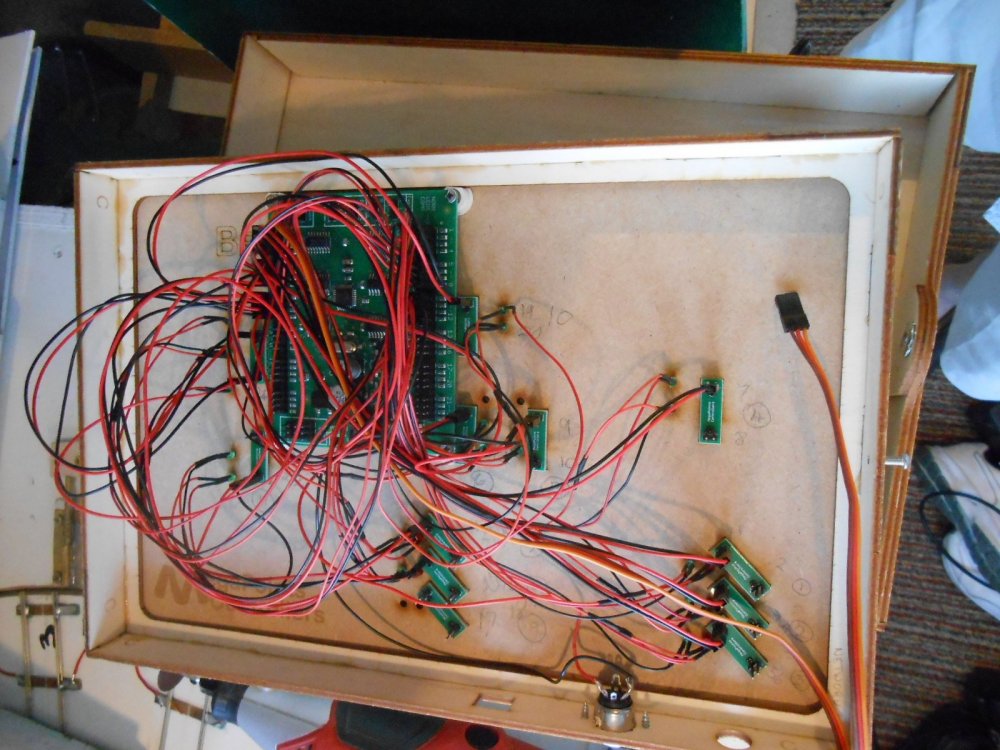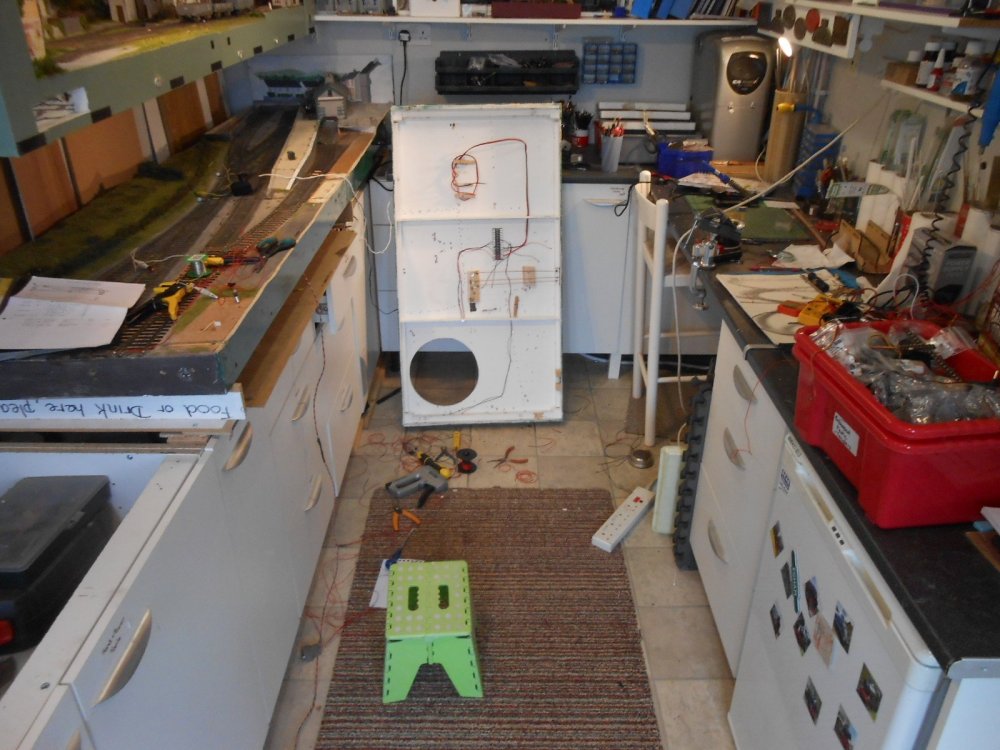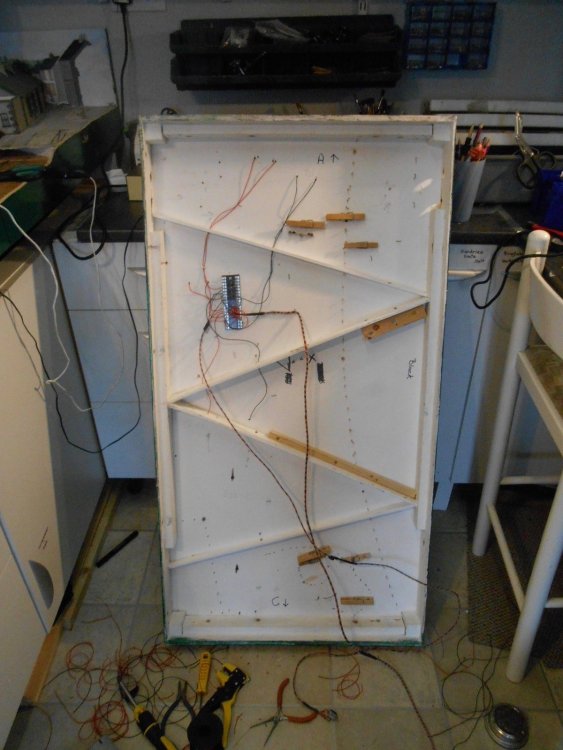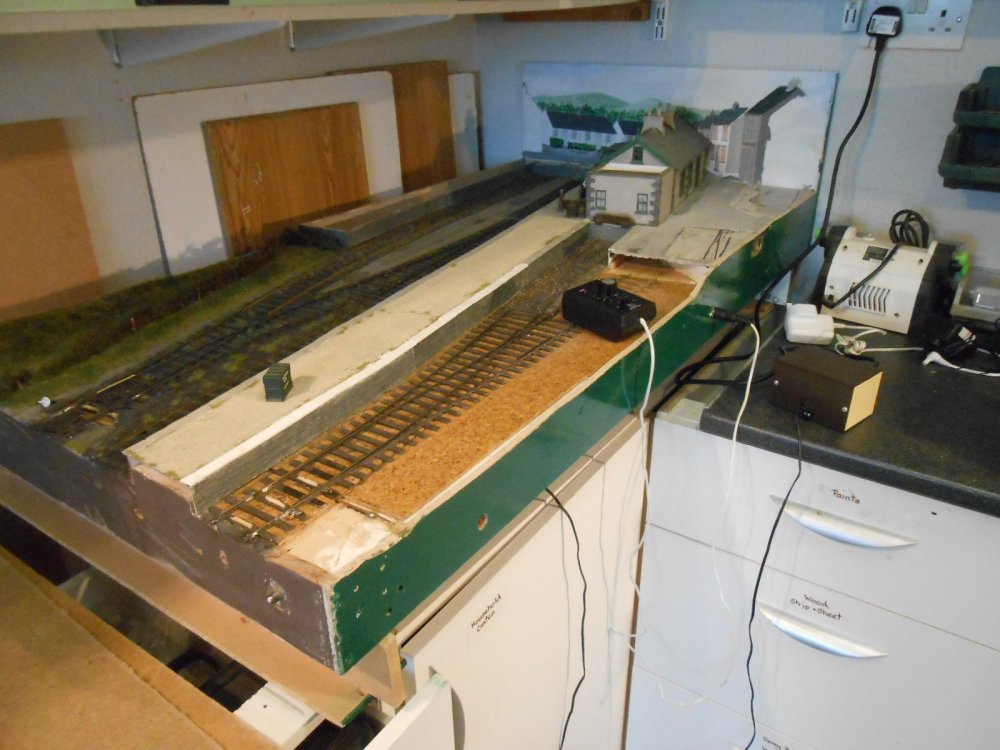
David Holman
Members-
Posts
4,359 -
Joined
-
Last visited
-
Days Won
117
Content Type
Profiles
Forums
Events
Gallery
Everything posted by David Holman
-
Cavan & Leitrim style 3ft track making
David Holman replied to PorkyP's topic in Irish Model Layouts
I made Fintonagh's 21 mm track from Peco Code 83 FB rail - they sell it as conductor rail, but it works fine for copper clad track and points with both 4mm finescale wagon wheels and Slater's three foot gauge, 7mm scale wheels. Used Templot for point drawings. They do 'Irish EM', 20.2 mm ones, but it was easy to enlarge them to 21mm on the home printer/copier. The only difficult hot was getting a suitable roller gauge, but eventually, someone turned one for me on the club lathe. What I would say is even using 4mmFS standards, clearances are tight. Wheel back to backs are around 19.5mm and anything more than 0.1 mm outside that can cause derailments, whereas in broad gauge (36.75mm) on code 100 track, I can get away with nearly 0.5mm either way. -
Excellent!
-
Great work - just goes to show that even in 2mm scale, the correct gauge has a real impact. Appreciate it is not for everyone, but does make a difference.
-
A trick of the light, Mick. Track wiring is red and black, network wiring is red, white and black, while for some reason, the servo leads are red, brown and yellow. My mobile phone case is VERY pink though, but only because that was the only colour they had. Even so, still manage to lose round the house!
-
More Wiring Trials Spent the last week faffing about with point control wiring. I've invested a fair wedge of my hard earned on a Megapoints control system. This has included: A custom made control panel, complete with Belmullet lettering and mimic diagram A master control board, switches and LEDs to go in the panel and which work all the points and signals via a single network cable. Three Servo Driver boards, each controlling four points or signals, which go under the baseboards. The Megapoints stuff also requires its own 5 amp, 12v supply, plus several network cables to join the Servo Drivers together. Hence the under baseboard wiring has grown a bit, to say the least. However, the servos only cost £1.80 each [about a tenth of the price of Tortoise point motors and associated switching], while the entire system is pretty much 'plug and play', requiring the minimum of soldering. It is expensive though. So, what I now have is as follows: A mimic control panel with a lot of spaghetti inside. This comprises leads from the push button switches and LED indicators [green/green for point routing and red/green for signals], which go to terminals on the main processor. A 12v supply goes in from the transformer, with just a three strand network cable going to the layout, instead of around 30= wires if I had used ordinary point motors and toggle switches Baseboard 'C' [nearest the fiddle yard] will have the mimic panel fixed to it with a couple of quick mount plates. A single servo driver has four leads going from it to the three arm signal as seen on Arigna Town, plus the main turnout on entry to the station. There is then another three strand network lead going to the middle scenic board 'B'. Baseboard 'B' has two servo drivers. The first one has two leads to the double slip, with the other two going to what will be two new starter signals at the platform end. The second servo driver covers the point to the loco shed on Baseboard B, then two more network leads go to Baseboard 'A' to work the loco release crossover and the point to the end loading dock off the bay. On the one hand, much of it is fairly straightforward, but with my aforementioned ability to get things back to front, there has been a fair amount of bad language and a lot of head scratching to get it all set up. The system is quite clever, because it enables you to reverse the switches to ensure the lights on the mimic panel are going the right way, while the signal controls allow you to have them bounce and do the 'double pull' as seen on the real thing. In addition, the range of movement on the servos is controllable too - handy for ensuring points close properly. The downside appears to be that the servos, while cheap, may not be all that reliable, so I have ordered some spares already! It may well be prudent to protect the servo drivers with some sort of cover too, eventually. The photos may, or may not make the above clearer...
-
Puts my drawer of tinlets to shame and have seen exhibition stands less well stocked!
-
I seem to be dribbling....
-
Gresley Beat apparently needs two seven ton lorries, so a way to go yet maybe. There's plenty of us that would love to see Barrow Street. Magazine articles at least, hopefully
-
Might need to book Pickford's too!
-
Love small projects like this. A chance to focus on fine detail and use/display all those fine models.
-
The knees of the bee, the mutt's nuts, the... Fab.
-
Chris Nevard is a scenic master in the Gordon Gravett class, with many cameo layouts and dioramas to his name. Using Das Clay looks ideal because what you want is a very fine surface, which even using N gauge cinders would be too coarse. Sifting in a bit of fine sand might be appropriate in a few places, while an electrostatic grass machine works wonders for foliage. Peco have a new Mini version out, which is good for tight corners and small areas, though the original Noch puffer bottles remain surprisingly effective. Beware bright shades of green though. However good Ireland's liquid sunshine is for the green stuff, I'd still err on the yellow/straw shade of things. And get the lady in your life to check the tones. Gentlemen beyond a certain age lose the ability to see shades of green, while our women folk would say we don't have much colour sense in the first place!
-
Organised Chaos Or wiring, in other words. Wiring for me is a necessary evil. Trains won't run without electrickery, but my knowledge is of the 'just enough and no more' variety. However, the biggest problem is my mild dyspraxia - or at least that is how I think of it. Clumsy, a bit, but the main problem is really struggling with anything 'handed'. If there are two ways to put something together, I will do it wrong first, no matter how many times I think about it, while anything with rotational symmetry is a nightmare! Assembling flatpack furniture always takes twice as long as it should do... Wiring a layout is an exquisite type of agony, because you have to reverse what is on top of the baseboard when you wire underneath and likewise plugs and sockets. So, am feeling rather pleased with myself today, because I've managed to rewire the Arigna boards and they work!! I should have taken pictures of the bird's nest of spaghetti that had grown under the original boards, but suffice to say what you can see below is a whole lot neater. Those who know about such things will no doubt have done the job differently, but it works for me. Changes from Arigna are as follows: There is now just a single controller socket on the front of the station board, instead of the four that were there previously. This profligacy was simply because firstly Arigna was operated from the rear at shows, but I needed a front socket for home use. Doubling up both was to accommodate my spare controller, which had a different plug on it. I am sure you are already wondering why I didn't fit the same plug to both controllers, but it seemed like a good idea at the time. I have long realised my mind doesn't always work logically! A Tag strip with 72 loops [2 x 18 double strips] has been fitted under each board. All wiring goes to these first & this is then split and sent to track feeds and baseboard sockets. Staples help keep the wiring fairly neat. Wiring is now just red and black - one colour for each track, with a wiring diagram that tell me which tag strip goes to which feed, socket, etc. Under the Arigna boards, colours were rather mixed at random, using whatever I had to hand at the time. I know... While only 8 wires goes from Baseboard 1 to Baseboard 2 [and only 4 wires from 2 to 3], I have used 15 and 9 pin computer plugs and sockets to keep any stray wires away from touching each other. Baseboard 2's tag strips have leads going from them to the other two boards. In storage or transit, these leads are kept tidy by using clothes pegs hot glued to the underside of the boards. Point and signal control will be by servos, using Megapoints units and a custom made panel. This will be on Baseboard 3 at the fiddle yard end. The Fiddleyard operator will also be the signalman, with the driver at the station end, where all the uncoupling magnets will be too. Although I have no intention of using DCC, it would be nice to have a steam whistle/diesel horn unit, for the driver to call attention to the signalman. Better than shouting down the layout, methinks... Chances are, the signalman will also work the turntable, as it will be easier to align the tracks than from 10 feet away, where the driver will be. Anyway, the above has taken me much of the last week and a lot longer thinking about it. And yes, I did get everything back to front on the first board and had to redo it. Needless to say, a few rude words were uttered. More than a few, in fact. The photos show the undersides of the boards and the chaos that reigned all around me while I was doing it. It took rather a long time to tidy up!
-
With the addition of a fiddle yard, plenty of shunting layouts have been operated in less. Equally, methinks you are having plenty of fun with the modelling and that is what it is all about. Coming on beautifully.
-
Some lovely detail there.
-
Fabulous pictures. Especially like the one with a ground signal disc on the post.
-
Saxby and Farmer equipment used by some lines, not least SLNCR.
-
Splendid. Well done chaps
-
Lovely job.
-
Straight joints are easy enough, but as you've found, angled ones pose problems. One way around it is to solder the rails to screws, then add cosmetic sleepers in and around them. The main thing though is how nice and flush/tight the baseboard joins are and that is not easy either!
-
That's the idea, though compared to weathered black (which covers a multitude of sins), a pristine, lined finish requires a lot more effort. There again, it is all about challenging myself, so fingers crossed! Not much been happening with Belmullet recently. Am still waiting for my control components to arrive from Megapoints ( no point in doing scenery before wiring is completed), while four shows in quick succession for Fintonagh has taken up much of my spare time.
-
Suggest you use strong glue, like 5 min epoxy to join sleeper assembly to the baseboard. The alternative is to use small brass screws, in line with rails and make dummy sleepers to disguise them - three parts: middle and two outers.
-
Splendid stuff!
-
Never ceases to amaze me at the stuff that it out there. A 2mm 3D printed SLNCR railcar for goodness sake - and looks good too! Can the body be articulated I wonder? Don't know a lot about 2FS, but would think Code 40 rail should be fine, especially compared to Peco's Code 55 and the wider gauge would definitely set the scene.
.png.c363cdf5c3fb7955cd92a55eb6dbbae0.png)


